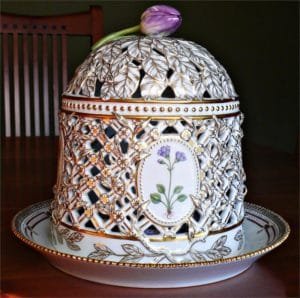The rare 18th century Ice Bell

Flora Danica’s Ice Bell, by Royal Copenhagen
So what is an Ice Bell and what does it (or doesn’t it) have to do with ice cream? The answer is at the bottom of the Research Rabbit Hole.
So, most of you have been chillingly aware (ok, I know low hanging fruit and I’m sorry but I couldn’t help myself) that I have been researching ice cream in the Georgian era over the past couple months. It was utterly inevitable that I end up in several research rabbit holes as part of the process. No surprise there, right? You guys know me by now!

So, as I was researching ice cream pails, cups and spoons, I came across this lovely piece of porcelain work, the Ice Bell. Gorgeous, isn’t it? I was entranced. What did one do with such a thing? Where and when did it come from? Why did NOTHING I had read to date mention such an alluring article?
I thought it would be a fairly simple search, but it turns out, it wasn’t. All the sources I could find called this piece an Ice Bell or Ice Dome made by Royal Copenhagen. The first examples came from 1783. Apparently Royal Copenhagen was the ONLY company who ever made this piece of porcelain ware, or so my resources have said. The one above is in a pattern called Flora Danica and is considered one of the most expensive and luxurious china patterns in production today. It was originally commissioned by Danish Crown Prince Frederick in 1790 as a gift for the Russian Empress Catherine the Great. Sadly, she died before the set was complete, so she was never to see the amazing china made for her.
The ice dome was part of a banqueting set–in other words, very few were ever made. They were a small number of contemporary examples made to celebrate the 200th birthday ofthe Flora Danica pattern. The process to make them is mind-blowing. The clay must be hand cut after it is molded, then hand painted in multiple, botanically accurate steps. Through the process, it is fired at least sixteen different times! Who knew? Prices on these ice bells range from $15,000 to $40,000 a piece. No, those aren’t typos. These are pretty serious collector’s pieces.
Not well suited for serving ice cream
But what are these porcelain wonders for? Here’s where it gets really interesting. Because only one manufacturer ever produced them, it’s difficult to find any reference to how they were used. Several sources suggest that they were used to serve large iced desserts. Trouble is, that it doesn’t make any sense. First of all the domes are only about 14 inches high and the platters they sit on 15 inches across. Compared to the large molded ices of the Georgian era, these were not big enough to serve them. Not to mention that those were show stopping pieces, serving them under a pierced dome makes no sense. You either cover them up for a big reveal, or leave them open for diners to admire. Halfway between is just anticlimactic.
Maybe they were to serve ice cream ‘in the rough’, in other words, ice cream that was not molded. Trouble with that is they would do little to keep the ice cream cold during a dinner service. Ice pails, designed to hold ice and salt could do an admirable job of that. Not to mention they were beautiful in their own right. Ice bells had no place for the ice and the holes in the dome would defeat any insulating properties the porcelain might have.
China pieces, generally are designed for both utility and beauty. So serving ice cream from the ice bell seemed a bit ridiculous.
Finally I came across a mention of a news article from the Rome News-Tribune (April 22, 1990), Danish china survives 200 years, by Barbara Mayer. (http://dressedintime.blogspot.com/2012/03/mysterious-and-most-luxurious-ice-bell.html) Unfortunatley, I couldn’t turn up the original article, but the reference to it says this:
According to Ms Mayer, “Because Flora Danica was created as banquet china, there are some unusual pieces. One of the most spectacular is an ice dome, a 15-inch platter topped with a 14-inch-high dome made of open-work porcelain. The dome was to cover a large chunk of ice, which by evaporation would cool the dinner guests. Now it is used for dessert and sometimes mistakenly referred to as an ice cream dome.”
So, essentially the ice bell was a very early form of air conditioning for diners at banqueting tables during the Georgian era!
This actually makes sense. The dish under the dome could hold a large block of ice. The perforated dome would allow air to circulate around the ice while giving the diners something lovely to look at. I would never have guessed at the purpose, but it makes so much better sense than using it as a serving piece.
At last mystery (mostly) solved. Before we say goodbye to this lovely piece, here are some images of a few other ice domes and the platters that went beneath them.
So what do you think? Would you have guessed the purpose of these unusual china pieces?
References
Mysterious and Most Luxurious Ice Bell
https://torch.si.edu/2018/04/april-24-1990/
A Special Ice Dome as a Birthday Present








Wow! That was a fabulous rabbit hole. Imagine… an early form of air conditioning. Now it make sense. Recently, I’ve seen commercials for a new air cooling device. You pour in water and turn on the fan that blows across something holding the water. So we have water cooled air. So I guess a bowl of ice and natural air currents would circulate cooler air. Ingenious. However, in looking at the photo of the set… is there only one bell per set or were there several to be placed at strategic spots on the table? Or was this placed at the head of the table near the hostess? Not sure where it was placed for optimum efficiency. But… excellent research. Thanks for sharing.
It took a while to suss out what it was and what it did. I kept telling myself I was wasting time in the rabbit hole, but I couldn’t manage to let it go until I got to the bottom of it!
Well, I never would have guessed that but yes, it makes perfect sense. There is no way you could use it for ice cream (or anything else foodwise really).
Whatever, the examples shown are very pretty and I suppose you could also put pot pourri in one as the scent would come through the holes?
Thank you for sharing this Maria.
I suppose you could use it for potpourri, but considering the price on those ice bells, I’m thinking a pretty glass bowl would suffice. LOL
Your new-fangled air cooler was old back in 1960s Baghdad. Most houses did not have air conditioners, they had air coolers, a large box containing a fan which pulled outside air which was very hot but of low humidity through pads which were kept wet by a drip feed. The water evaporated cooling the air significantly and also increasing its humidity a bit. The main problem with them was that if they had been switched off the first blast of air through the pads was very musty and smelled bad.
Those are still used today in very dry climates. They definitely don’t work where I am as we’re essentially a swamp and our humidity is so high, adding more is just crazy talk!
So glad you went down the rabbit hole, so that when I went looking for this info, you had already found it! Thank you so much for the interesting discovery.
Wow! This is amazing. My bf deals in antiques, especially china and dinnerware and we were discussing flora Danica but the ice dome was a mystery. I had to know what it was. I’ve never seen anything like it. You gave me an answer! Thank you so much for posting.
The Elusive Flora Danica. Thank you for posting this information. I have heard stories from my grandmother telling about the Ice Dome that was placed on the table. The Flora Danica being the epitome of all wonders.
Royal Copenhagen still make the Flora Danica ice bell
https://floradanica.royalcopenhagen.com/the-collection/